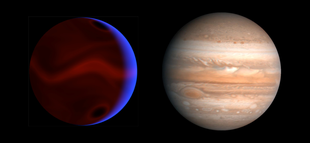HD 80606 b
|
Exoplanet HD 80606 b |
|
|---|---|
| Jupiter compared to HD 80606 b | |
| Constellation | Big Bear |
| Position equinox : J2000.0 |
|
| Right ascension | 09h 22m 37.577s |
| declination | + 50 ° 36 ′ 13.435 ″ |
| Orbit data | |
| Central star | HD 80606 |
| Major semi-axis | 0.449 ± 0.006 AU |
| eccentricity | 0.93366 ± 0.00043 |
| Period of circulation | 111.4367 ± 0.0004 |
| Further data | |
| radius | 0.921 ± 0.036 R J |
| Dimensions | 3.94 ± 0:11 M J |
| distance | 66.5 pc |
| method | Radial velocity method |
| Orbit inclination | 89.285 ± 0.023 deg |
| history | |
| discovery | Dominique Naef et al. |
| Date of discovery | 2001 |
HD 80606 b is an exoplanet that orbits the yellow dwarf star HD 80606 every 111.4 days . Due to its mass , it is assumed that it is a gas planet . Because its orbit is so eccentric, it is one of the eccentric Jupiters .
discovery
The discovery of the planet with the help of the radial velocity method in 2001 was based on observations with the Echelle spectrograph ELODIE at the 1.93 m telescope of the Observatoire de Haute-Provence .
Circulation and mass
The star system HD 80606 is located a little over 200 light years from Earth. The planet orbits its star at a mean distance of approx. 0.45 AU with an eccentricity of 0.93 and an orbital period of 111.4 days. The observation of a short-term minimum in a near-infrared light curve from HD 80606 is interpreted as the cover of the planet by the star and enables the orbit inclination to be determined to i ≈90 °, i.e. H. the earth is quite exactly in the orbit plane of HD 80606 b. The planet has a mass of about 4 Jupiter's masses and its radius is similar to that of Jupiter, making it more dense than this.
climate
Due to the high orbital eccentricity, the planet's distance from the star varies between 130 million kilometers in the apastron and 5 million kilometers in the periastron . The mean temperature is estimated at 700 K (430 ° C). During the passage of the periastron, however, the planet receives a radiation flux that is over 800 times larger than in the apastron and leads to a short-term strong heating of the planet. Observations in the near-infrared spectral range with the Spitzer space telescope made it possible in November 2007 to directly measure the temperature profile during a periastron passage. A rapid rise in temperature from around 800 K to 1500 K within six hours was observed. The atmosphere of HD 80606 b reacts much faster to changes in the radiation flux than the terrestrial atmosphere would (the time scale for the stratosphere is around three to five days). According to atmospheric models, the heating of the star-facing side of the planet leads to the formation of shock waves and extremely strong winds, the top speeds of which are assumed to be up to 18,000 km / h.
Web links
Individual evidence
- ↑ HD 80606 b. In: SIMBAD . Center de Données astronomiques de Strasbourg , accessed September 8, 2018 .
- ↑ a b c d e HD 80606 b. In: Extrasolar Planets Encyclopaedia . Retrieved September 8, 2018 .
- ↑ HD 80606 b. In: NASA Exoplanet Archive . Retrieved September 8, 2018 .
- ↑ HD 80606. In: SIMBAD. Center de Données astronomiques de Strasbourg, accessed September 8, 2018 .
- ↑ D. Naef et al .: HD 80606 b, a planet on an extremely elongated orbit . In: Astronomy & Astrophysics . Vol. 375, 2001, pp. L27-L30 , doi : 10.1051 / 0004-6361: 20010853 .
- ↑ a b G. Laughlin et al .: Rapid heating of the atmosphere of an extrasolar planet . In: Nature . Vol. 457, January 2009, pp. 562-564 , doi : 10.1038 / nature07649 .
- ↑ a b R. Kwok: Exoplanet gets hot flashes . January 2009 ( Nature News ).

